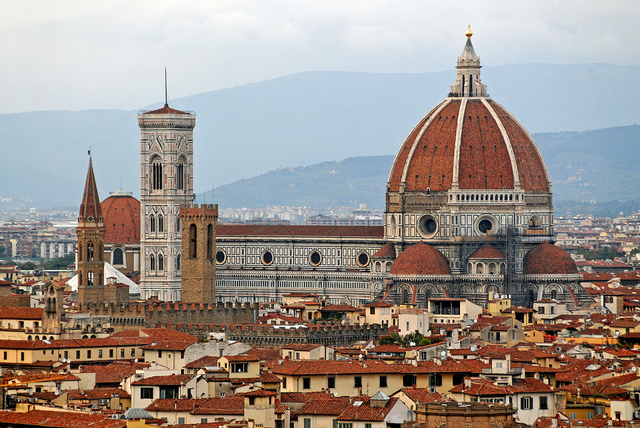5 Minute Guide to Florence, Italy
Florence is home to some of the most famous works of art in the world, larger than life religious architecture, and Italy’s finest culinary scene. Its postcard picture views have consistently adorned travel guides as one of the top destinations not only in Italy, but also across Europe and the globe. It is a small historical city, where visitors can see most of the major sites by foot. Whether you are visiting Florence for work or pleasure, there are a few key points to keep in mind while exploring the city of Renaissance.

Photo of The Duomo via flickr / Dennis Jarvis
Top Attractions
Many call Florence the “cradle of Renaissance” due to its quantity of churches, monuments, museums, and architecture dating back to the Renaissance period. The historic centre of Florence was declared a UNESCO World Heritage Site in 1982, which means everywhere you walk in the centre is pretty special! The most notable site in Florence is the cathedral known as The Duomo, built by Filippo Brunelleschi in 1436. The dome is still the largest dome in the world built by brick and mortar. Close by, the Baptistery and Campanile buildings are architectural highlights. Take in the medieval walls that surround the city and the Fountain of Neptune statue in the Piazza della Signoria square in the heart of the city.

Photo of Fountain of Neptune via Wikipedia / MarcusObal
Food
Florence serves up traditional Italian fare along with its own regional specialties. Devour classics like lasagna, ravioli, pizza, caprese, and a variety of antipasti appetizers such as cured meats. Local dishes focus mainly on meats, utilizing all parts of the animal. Look out for bistecca alla fiorentina, a large T-Bone steak cooked over hot charcoal and served very rare. Many dishes are cooked in olive oil, a famous product from the region. A typical dessert in Florence is the white bread cake schiacciata alla fiorentina.
Transportation
Including many of the major tourist attractions, most of the quaint city is completely walkable. Most of the streets in the centre are closed to auto traffic! Enjoy the cobblestone streets and the beautiful surprises at every turn. There are local busses you can take to further destinations like the train station, meandering around the town. Hop on and pay your fare into the machine on the bus. If you are travelling to other parts of Italy, you can use the main train line, Trenitalia.

Photo of Ponteveccio Bridge via pixabay / Mariamichelle
Language
The residents of Florence speak fiorentino, a Tuscan dialect of modern Italian. Differences are noted in vocabulary and pronunciation. The Florentine accent is very recognizable in Italy, commonly referred to as gorgia toscana. The hard C sound is pronounced more like the English H sound. Famous literary works by Dante, Petrarch, and Boccaccio preferred to use fiorentino instead of Latin. If you are travelling to Florence, it is a great idea to brush up on your Italian skills. Start by examining your current language level and then choose which Italian course is best for you. Make sure you order that T-Bone steak in Italian during your visit!
